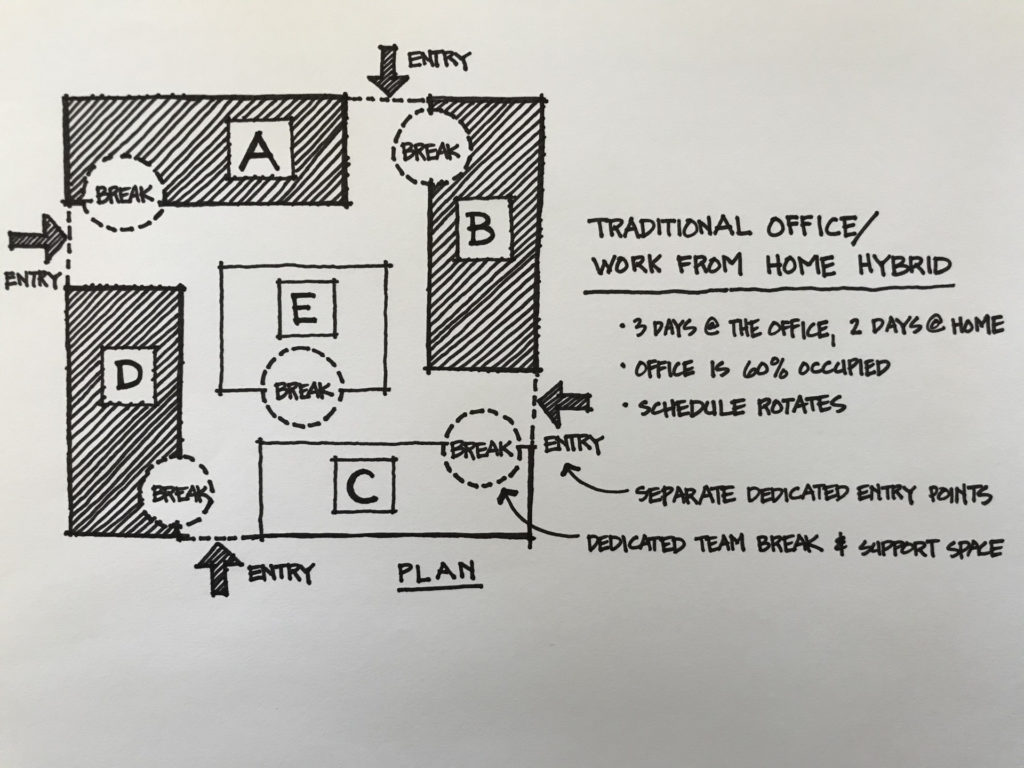Now that I am back in the office I have again hit my stride in productivity, am fully engaged with my team, and completely understand the “new normal” that I have been reading about. I have all the answers.
Said no one. Ever.
We will all agree that the exact opposite is true. We do not have the answers as we adapt how we work and engage with one another. We recognize that the “new normal” is a journey and not a destination, as cliché as that may sound. The way we live and interact with one another and with place, may always be changing – a forced flexibility as part of our evolution.
One of the tremendous victories coming out of the pandemic quarantine was our need to continue speaking with one another and seeing one another. We leveraged technology to continue our work, meetings, and happy hours. We demonstrated to one another how we can be productive while being remote. The practice of working from home suddenly rivaled the traditional office culture in its effectiveness and value.
Then why do we go to work?
Why then are we willing to accept that so much of our financial overhead is dedicated to our traditional work spaces? As planners and designers, the answer to this question is essential to the services we provide, and in the interest of transparency an answer that runs the risk of putting us out of business.
Our belief is grounded in an understanding that as humans we need to connect personally and physically in environments that are shared, and that these environments frame and elevate our experiences. Our spaces – our work spaces – have the ability to make us better at what we do. In addition, the experiences we take with us from these spaces make us better individually at who we are.
We work because:
- We need cultural and social interaction.
- We need to collaborate with one another and be accountable to one another.
- We need to share ideas and be creative.
- We need to have purpose.
- We need to maintain a standard of living.
But there is a subtle and very important distinction in this reasoning that cannot be overlooked. The question “why do we work” is very different than “why do we go to work.” Much of the value that we need from work is not tied to place. Much of the value that we need from work is preserved – or even improved – in working remotely. The reality, however, is that each model offers real benefits and certain advantages over the other.
The traditional office
Physical contact is an intangible that is only possible by bringing people together in the same setting. Nextiva Marketing Manager and author Jeremy Boudinet offers that “face to face communication is something you really only get in an office space. It’s not only beneficial when planning for business, but it strengthens relationships and rapport with other employees. There’s something about relationship-building that happens when you sit next to someone or bump into each other at the coffee machine.”
The workplace also affords greater access to technology, more impromptu interactions, and a stronger cultural connection. It is also “simply where the magic happens.” It is, quite frankly, difficult for employees to connect with co-workers when everyone is working from home. One study suggests as many as 70% of employees view relationships with co-workers just as important as their jobs. It is also well documented that in addition to separation, reduced communication, and even loneliness, working from home does not afford a clean break in leaving the office, making it hard to unplug after work.
Working from home
Working from home has its benefits, however, by eliminating commute, reducing stress, and resulting in better focus and increased productivity. Working from home can boost productivity by 13% and significantly reduce interruptions. A University of California Irvine Study found that a typical office worker is interrupted every 11 minutes, with it taking twice as long to then get back on track. In addition to interruptions, discussion of non-work topics cuts into productivity. Remote employees spend about 30 minutes of each day discussing non-work topics while their office counterparts spend more than an hour of each day socializing.
Increased productivity, innovation, and level of engagement top the list of benefits to working from home. This is well documented, as is the belief that remote employees feel more autonomous and empowered, and have a greater sense of work-life balance.
Work-life balance
Balance is key.
In considering traditional office work versus working from home, “we find that neither extreme is best. Gallup surveys show that fully remote workers are among the least engaged of any worker, but so are employees who always come in. Just 30% of employees in both groups are engaged.“
So if we consider that there are benefits to working in a traditional office space and in working from home, we should also consider that the greatest value may come in striking a balance between these options. Viewing this through the lens of socially healthy planning and design further reinforces this concept, and a hybrid solution emerges.
If we crudely apply a split to a typical five day work week and arbitrarily suggest that an employee would be in the office for three days and working remotely for two days, there would be a 40% reduction of staff within the office at any one time.
This is a 40% reduction in space usage.
A 40% reduction in interactions.
A 40% reduction in commuting.
I realize the actual percentages would be different. There are still common, shared spaces that would be needed regardless of how many individuals are in an office. Most interactions are with assigned team members and would be maintained. Commuting is tough to gauge with public transportation and differences that tie more closely to urban density. But the point is a good one – reduce the number of staff within the office and see reductions and improved outcomes elsewhere. Research and opinion already support that work product and employee satisfaction would improve as well.
The question becomes how to effectively implement this. The solution – like most planning solutions – is part operational and part architectural.

The solution
Operationally, one concept is to divide staff into different teams with these teams scheduled to be in the office at different times. This could mean five different teams (A through E) with three day, staggered schedules for being in the office. The result would be an overall occupancy of 60% at any time. Scheduling would then rotate so one week team A would be in the office Monday through Wednesday, the next week Tuesday through Thursday, and so on. This would equitably schedule the remote days relative to weekend time for all teams, and ensure that there would always be a different mix of teams within the office throughout the week.
Architecturally, this concept could be translated to seating assignments within the office. Admittedly, since the point of being in the office is to afford team interaction, teams would be assigned to dedicated work areas (well-planned and appropriately socially distanced). This would enable staff to make eye-contact, ask questions, and just walk over to someone else’s desk.
Collaborate.
If not, why be in the office at all?
The teams themselves however, could be separated, and supported by smaller common spaces for printing, supplies, coffee and breaks. Instead of a single print and supply room, and a single staff break room, think of five smaller, decentralized areas dedicated to support each of the teams.
Planning, like scheduling, would imply social firewalls to reduce unnecessary interactions while reinforcing those that are essential, and core to the life and success of traditional office environments.
What is next?
We are unsure what is next for the COVID-19 pandemic and are equally unsure how history will remember this time. What seems a reasonable thought, however, is that if the COVID-19 pandemic has a lasting impact that extends into next year then our attempts to hurry out cardboard and duct tape solutions to promote social distancing will have been tragically short-sighted. And similarly, if the impact is less than this then we are over-reacting.
Why do we go to work?
The greatest benefit coming out of quarantine is asking this question, thinking about it critically, and adapting our work processes and planning of our spaces accordingly. This should be a time of intelligent pause, taking stock in what we have, and developing a plan that balances the way our office schedules and spaces work together.
Part traditional office. Part working from home.
Part operational. Part architectural.

